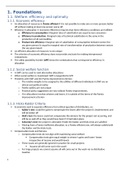Summary
Environmental and transportation economics complete summary
- Course
- Institution
Complete summary of the course Environmental and Transportation economics. The summary covers all the chapters and all the slides and covers everything that you should know for the exam.
[Show more]



